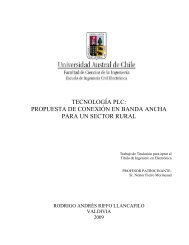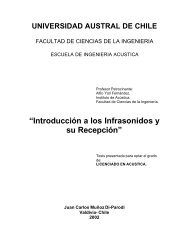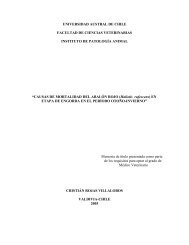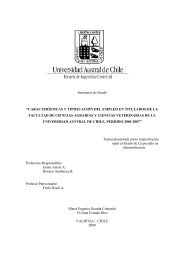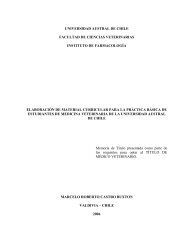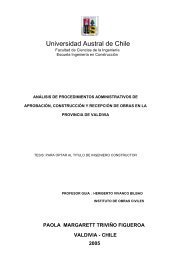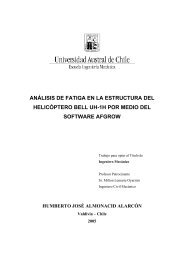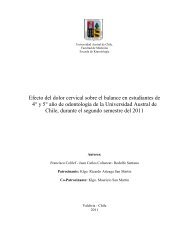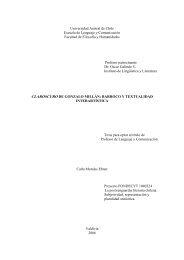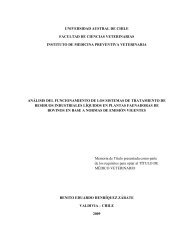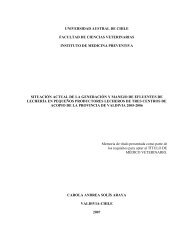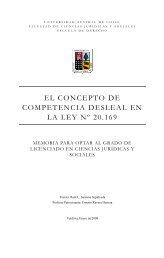Diversidad y control biológico de insectos - CyberTesis UACh ...
Diversidad y control biológico de insectos - CyberTesis UACh ...
Diversidad y control biológico de insectos - CyberTesis UACh ...
You also want an ePaper? Increase the reach of your titles
YUMPU automatically turns print PDFs into web optimized ePapers that Google loves.
were estimated using a dilution plating method on agar-oat-dodine selective media (Chase<br />
et al., 1986).<br />
Spore persistence in soil. Eight soil cores (9 cm diameter, 10 cm <strong>de</strong>ep) were extracted at<br />
random in each plot assigned to B. bassiana treatment. They were pooled and put in a<br />
plastic bag to get ca. 1-1.5 Kg of soil and cooled (5-10° C) prior to analysis. In the<br />
laboratory, the soil was sieved and litter and roots were removed. Fifteen grams of fresh<br />
soil were ad<strong>de</strong>d to a flask with 25 ml of sterilized distilled water and drops of Tween-20 as<br />
surfactant. In parallel, three samples of 100 g of soil were dried in a stove to measure the<br />
soil water content and express the number of colonies on a dry soil basis. The mix was<br />
shaken by hand for 5 min. An aliquot (2.5 ml) was transferred to a second tube and then<br />
sterilized water and Tween-20 were ad<strong>de</strong>d to complete 25 ml. The new tube was treated as<br />
above and when all the dilutions were available (10 -1 to 10 -3 ), we transferred 150 µl of<br />
suspension, using a pipette, to each plate with selective media (3 plates per dilution). The<br />
plates were cultivated for ten days (no light, 20° C) and colony forming units (CFU) were<br />
recor<strong>de</strong>d at the end of this period. A proportion of the colonies was sampled and correct<br />
i<strong>de</strong>ntification was confirmed by microscopic exam. Counts were corrected by water content<br />
to express the spore numbers on a dry soil basis. Spore number was estimated five times in<br />
the study: before and 1, 5, 15 and 66 days after spraying.<br />
Persistence of spores on leaves. Foliage samples were collected at random in each plot<br />
(10-15 points) and pooled. In the laboratory, pieces of leaves were cut with scissors,<br />
measured with a rule and ad<strong>de</strong>d still to complete 32 cm 2 per plot. Leaf pieces were ad<strong>de</strong>d to<br />
a tube with 25 ml of sterilized distilled water and drops of Tween-20. Then, the same<br />
procedure of soil samples was adopted. Spore numbers are expressed by fresh leaf area.<br />
Only ryegrass leaves were inclu<strong>de</strong>d in this analysis. Sampling was performed at 1, 4 and 7<br />
days after spraying.<br />
The dilution/transference process was repeated 3 times, therefore dilutions from 10 -1 to 10 -3<br />
were available, both soil and foliage samples. Only estimation from dilution 10 -2 were used<br />
to draw the soil persistence curve and the foliage persistence curve was drawn from 10 -1<br />
dilution data (Figure 1).<br />
107



